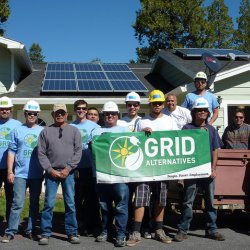Samuel White Swan-Perkins (TsaLaGi/Siksika) is the Communications Outreach Intern at the North Valley GRID Alternatives office. He is a cultural consultant, public speaker and a contributing writer for News From Native California, a quarterly journal from Heyday Press. Sam is a professional powwow dancer and singer as well as a member in good standing of the Kiowa Gourd Clan since 2009.
With the unprecedented growth seen in the solar sector last quarter, Fall 2014, it comes as no surprise that the industry is really “hot” in Indian Country.
Across the Nation, American Indian nations are scrambling to get on board with a newer form of technology that draws on an ancient, sacred source. Although some of the first solar installs in Indian Country began as early as 1999, various tribes such as the Oglala Lakota and Navajo Nation (Dine) have come on board, particularly as the US Government has designed funding and benefits specifically designed to help these projects along.
GRID Alternatives is leading the path through its innovative “barn-raising model”. Tribal members are exposed to valuable job training opportunities, a rare and exciting chance in an area where 50% unemployment is the norm. A 2006 report out of a local California State Social Services office reports 15 of 20 different rancherias reporting at least 50% unemployment. (STATE OF CALIFORNIA - HEALTH AND HUMAN SERVICES AGENCY, Department of Social Services, ALL COUNTY LETTER NO. 06-23, page 3, 2010). Given their often remote location, lack of access to modern conveniences such as electricity and running water and often a general lack of infrastructure altogether, one can easily see how this could add up to to a difficult situation. Even when these necessities are in place, government entities often work to create a bureaucratic nightmare for those wishing to do business on “the rez”.
Tribal nations once exercised their own sovereignty, their ability to choose the course of their shared destiny for themselves. Now, federally recognized Natives must rely on the BIA or BLM to approve the most trivial matters in their personal lives. The GRID Alternatives model is empowering as tribal homeowners work side-by-side with volunteers over the course of a week or so to see the install through. After the installation and training is complete, the Tribe is left on their own to manage, maintain and control the panels. This model serves to empower the Nations: it allows them to exercise their sovereignty and to learn valuable skills in a rapidly growing green collar economy. Due to the remote locale of many of the installations, the families who are having the install completed for them must be willing to contribute a traditional gift, in this case, lunch. This can be an exciting opportunity for non-natives as they are exposed to traditional regional foods such as piki or fry bread, mutton or buffalo stew or chili or hominy and venison. Exposure to these traditional foodways helps to create a bond for the entire group as well as a memorable experience for non-native GRID Alternative staff. These foods are often gathered or harvested by hand by the Nations’ themselves and often provide a healthy alternative to fast food and the like.
GRID Alternatives helps Native nations who are interested in investing their time and energies toward a relatively new and rapidly growing industry. Our California Tribal Program began with the partnership between La Jolla Band of Luiseño Indians and GRID Alternatives. In a previous blog post from GRID Alternatives' regional office in San Diego, Rob Roy, the Environmental Director for the La Jolla band, stated, “GRID’s program has been so wonderful in assisting low-income people to go solar, which in turn increases their pride in their reservation and in their homes, and helps promote self-sufficiency.” In one particular case, a homeowner saw a decrease of around $100 in his monthly heating bill. Although $100 may not sound like much, consider that American Indians, despite the mainstream media claims of Natives becoming wealthy from casino earnings, continue to stay at the bottom of the economic ladder. Many live under the poverty level (earning less than an annual income of $23,850 for a family of four), so an extra $100 a month may go toward a childs’ shoes or school supplies, for example. Ten homes on the San Diego area rancheria were adapted with solar panels on that single project; one can extrapolate that figure out for a projected savings of $740,000.00.
There is no doubt that solar can change the lives of Natives and other impoverished communities in our Nation. With GRID Alternatives leading the solar industry with culturally competent partnerships, no doubt we’ll be working with Indian Country for a long time to come.

